HR Strategy and Organizational Culture: OBI's Transformation Analysis
VerifiedAdded on 2022/10/15
|11
|2729
|14
Report
AI Summary
This report critically examines OBI's strategic human resource management practices during its transition from a multi-domestic to a transnational strategy. The analysis begins by exploring the best-fit and best-practice dilemmas inherent in this shift, focusing on the impact on organizational culture and the broader cultural factors across different countries. The report evaluates the HR strategy implemented to achieve standardization, identifying issues from the headquarters' perspective, and considering the needs of the subsidiaries. It argues the success of the approach in balancing the needs of both headquarters and subsidiaries, and proposes and justifies additional actions that HR should focus on to ensure effective implementation. The report highlights the challenges of cultural differences, the need for expatriates, and the importance of communication and coordination in this transition. The core focus is on the development of standardized procedures for recruitment and human resource management, aiming to control operations across various stores while addressing the complexities of international expansion and cultural nuances.
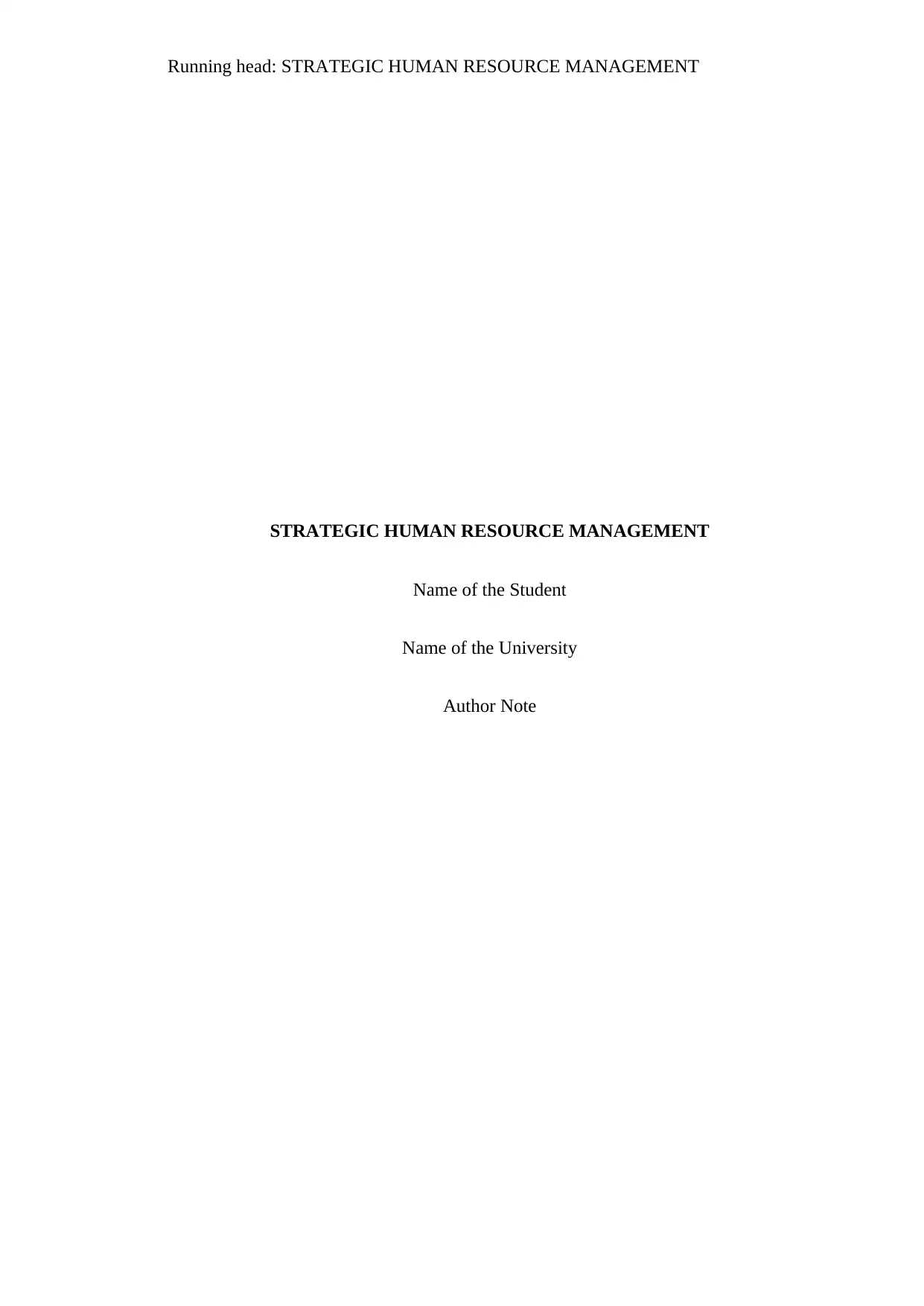
Running head: STRATEGIC HUMAN RESOURCE MANAGEMENT
STRATEGIC HUMAN RESOURCE MANAGEMENT
Name of the Student
Name of the University
Author Note
STRATEGIC HUMAN RESOURCE MANAGEMENT
Name of the Student
Name of the University
Author Note
Paraphrase This Document
Need a fresh take? Get an instant paraphrase of this document with our AI Paraphraser
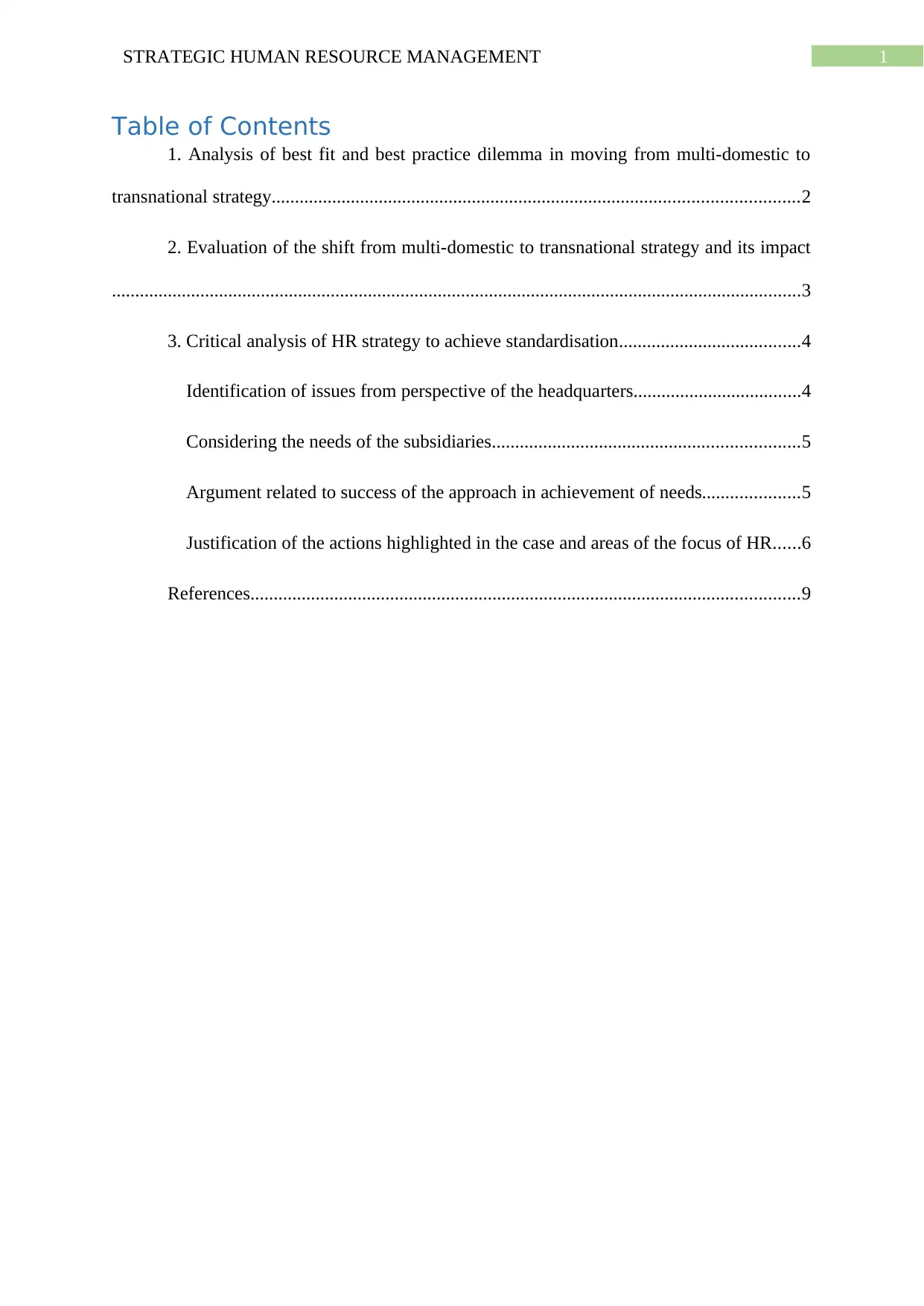
1STRATEGIC HUMAN RESOURCE MANAGEMENT
Table of Contents
1. Analysis of best fit and best practice dilemma in moving from multi-domestic to
transnational strategy.................................................................................................................2
2. Evaluation of the shift from multi-domestic to transnational strategy and its impact
....................................................................................................................................................3
3. Critical analysis of HR strategy to achieve standardisation.......................................4
Identification of issues from perspective of the headquarters....................................4
Considering the needs of the subsidiaries..................................................................5
Argument related to success of the approach in achievement of needs.....................5
Justification of the actions highlighted in the case and areas of the focus of HR......6
References......................................................................................................................9
Table of Contents
1. Analysis of best fit and best practice dilemma in moving from multi-domestic to
transnational strategy.................................................................................................................2
2. Evaluation of the shift from multi-domestic to transnational strategy and its impact
....................................................................................................................................................3
3. Critical analysis of HR strategy to achieve standardisation.......................................4
Identification of issues from perspective of the headquarters....................................4
Considering the needs of the subsidiaries..................................................................5
Argument related to success of the approach in achievement of needs.....................5
Justification of the actions highlighted in the case and areas of the focus of HR......6
References......................................................................................................................9
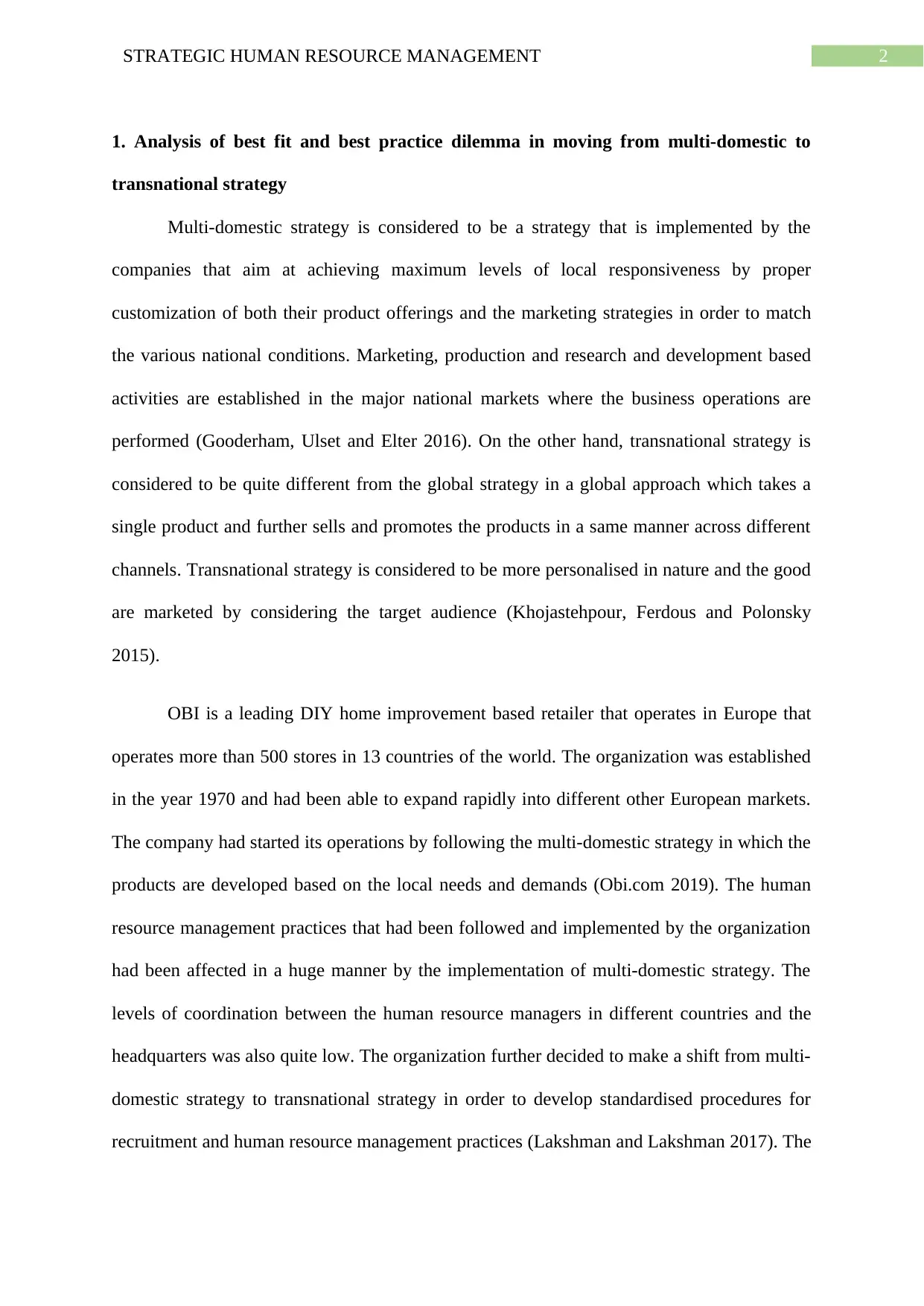
2STRATEGIC HUMAN RESOURCE MANAGEMENT
1. Analysis of best fit and best practice dilemma in moving from multi-domestic to
transnational strategy
Multi-domestic strategy is considered to be a strategy that is implemented by the
companies that aim at achieving maximum levels of local responsiveness by proper
customization of both their product offerings and the marketing strategies in order to match
the various national conditions. Marketing, production and research and development based
activities are established in the major national markets where the business operations are
performed (Gooderham, Ulset and Elter 2016). On the other hand, transnational strategy is
considered to be quite different from the global strategy in a global approach which takes a
single product and further sells and promotes the products in a same manner across different
channels. Transnational strategy is considered to be more personalised in nature and the good
are marketed by considering the target audience (Khojastehpour, Ferdous and Polonsky
2015).
OBI is a leading DIY home improvement based retailer that operates in Europe that
operates more than 500 stores in 13 countries of the world. The organization was established
in the year 1970 and had been able to expand rapidly into different other European markets.
The company had started its operations by following the multi-domestic strategy in which the
products are developed based on the local needs and demands (Obi.com 2019). The human
resource management practices that had been followed and implemented by the organization
had been affected in a huge manner by the implementation of multi-domestic strategy. The
levels of coordination between the human resource managers in different countries and the
headquarters was also quite low. The organization further decided to make a shift from multi-
domestic strategy to transnational strategy in order to develop standardised procedures for
recruitment and human resource management practices (Lakshman and Lakshman 2017). The
1. Analysis of best fit and best practice dilemma in moving from multi-domestic to
transnational strategy
Multi-domestic strategy is considered to be a strategy that is implemented by the
companies that aim at achieving maximum levels of local responsiveness by proper
customization of both their product offerings and the marketing strategies in order to match
the various national conditions. Marketing, production and research and development based
activities are established in the major national markets where the business operations are
performed (Gooderham, Ulset and Elter 2016). On the other hand, transnational strategy is
considered to be quite different from the global strategy in a global approach which takes a
single product and further sells and promotes the products in a same manner across different
channels. Transnational strategy is considered to be more personalised in nature and the good
are marketed by considering the target audience (Khojastehpour, Ferdous and Polonsky
2015).
OBI is a leading DIY home improvement based retailer that operates in Europe that
operates more than 500 stores in 13 countries of the world. The organization was established
in the year 1970 and had been able to expand rapidly into different other European markets.
The company had started its operations by following the multi-domestic strategy in which the
products are developed based on the local needs and demands (Obi.com 2019). The human
resource management practices that had been followed and implemented by the organization
had been affected in a huge manner by the implementation of multi-domestic strategy. The
levels of coordination between the human resource managers in different countries and the
headquarters was also quite low. The organization further decided to make a shift from multi-
domestic strategy to transnational strategy in order to develop standardised procedures for
recruitment and human resource management practices (Lakshman and Lakshman 2017). The
⊘ This is a preview!⊘
Do you want full access?
Subscribe today to unlock all pages.

Trusted by 1+ million students worldwide
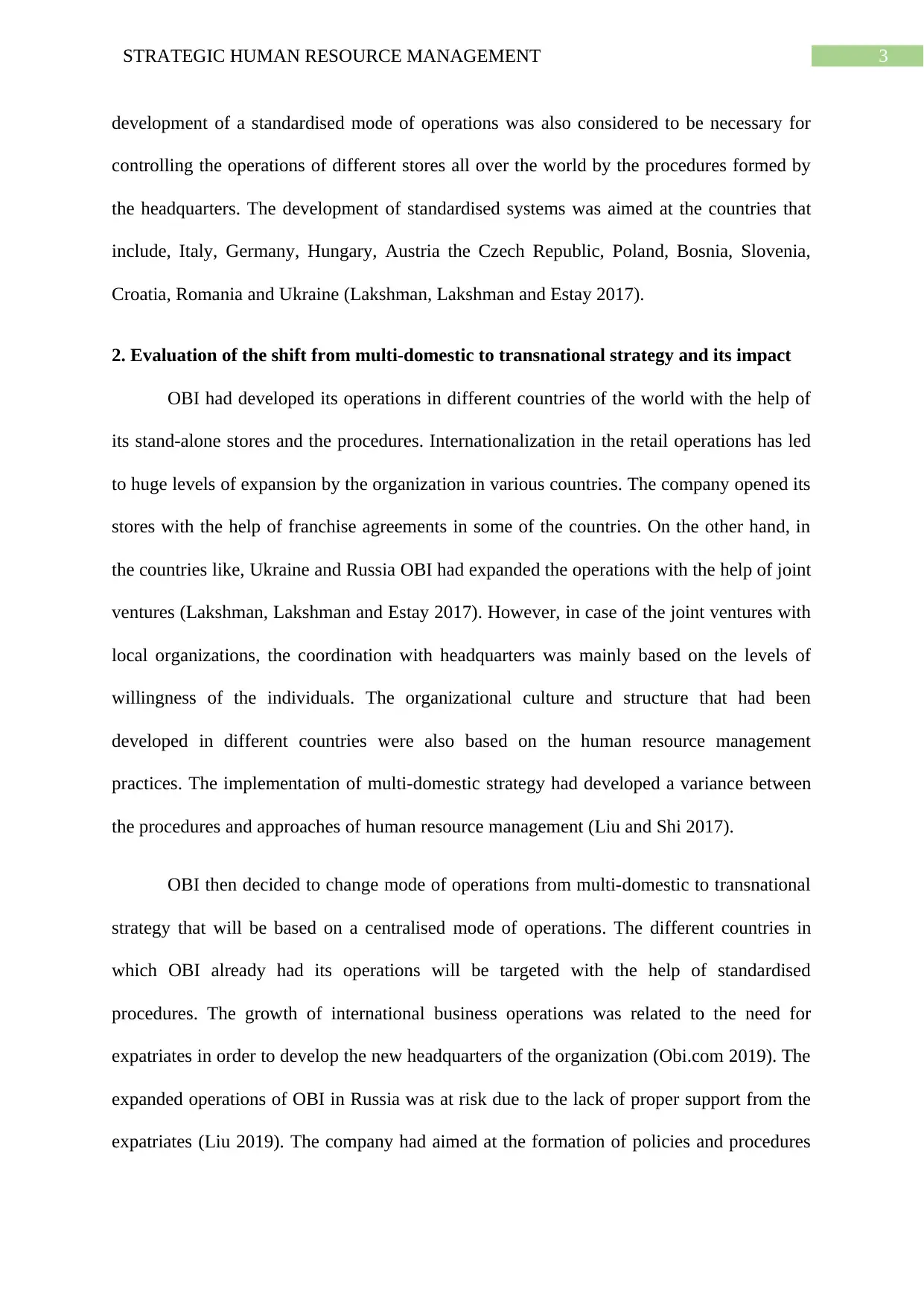
3STRATEGIC HUMAN RESOURCE MANAGEMENT
development of a standardised mode of operations was also considered to be necessary for
controlling the operations of different stores all over the world by the procedures formed by
the headquarters. The development of standardised systems was aimed at the countries that
include, Italy, Germany, Hungary, Austria the Czech Republic, Poland, Bosnia, Slovenia,
Croatia, Romania and Ukraine (Lakshman, Lakshman and Estay 2017).
2. Evaluation of the shift from multi-domestic to transnational strategy and its impact
OBI had developed its operations in different countries of the world with the help of
its stand-alone stores and the procedures. Internationalization in the retail operations has led
to huge levels of expansion by the organization in various countries. The company opened its
stores with the help of franchise agreements in some of the countries. On the other hand, in
the countries like, Ukraine and Russia OBI had expanded the operations with the help of joint
ventures (Lakshman, Lakshman and Estay 2017). However, in case of the joint ventures with
local organizations, the coordination with headquarters was mainly based on the levels of
willingness of the individuals. The organizational culture and structure that had been
developed in different countries were also based on the human resource management
practices. The implementation of multi-domestic strategy had developed a variance between
the procedures and approaches of human resource management (Liu and Shi 2017).
OBI then decided to change mode of operations from multi-domestic to transnational
strategy that will be based on a centralised mode of operations. The different countries in
which OBI already had its operations will be targeted with the help of standardised
procedures. The growth of international business operations was related to the need for
expatriates in order to develop the new headquarters of the organization (Obi.com 2019). The
expanded operations of OBI in Russia was at risk due to the lack of proper support from the
expatriates (Liu 2019). The company had aimed at the formation of policies and procedures
development of a standardised mode of operations was also considered to be necessary for
controlling the operations of different stores all over the world by the procedures formed by
the headquarters. The development of standardised systems was aimed at the countries that
include, Italy, Germany, Hungary, Austria the Czech Republic, Poland, Bosnia, Slovenia,
Croatia, Romania and Ukraine (Lakshman, Lakshman and Estay 2017).
2. Evaluation of the shift from multi-domestic to transnational strategy and its impact
OBI had developed its operations in different countries of the world with the help of
its stand-alone stores and the procedures. Internationalization in the retail operations has led
to huge levels of expansion by the organization in various countries. The company opened its
stores with the help of franchise agreements in some of the countries. On the other hand, in
the countries like, Ukraine and Russia OBI had expanded the operations with the help of joint
ventures (Lakshman, Lakshman and Estay 2017). However, in case of the joint ventures with
local organizations, the coordination with headquarters was mainly based on the levels of
willingness of the individuals. The organizational culture and structure that had been
developed in different countries were also based on the human resource management
practices. The implementation of multi-domestic strategy had developed a variance between
the procedures and approaches of human resource management (Liu and Shi 2017).
OBI then decided to change mode of operations from multi-domestic to transnational
strategy that will be based on a centralised mode of operations. The different countries in
which OBI already had its operations will be targeted with the help of standardised
procedures. The growth of international business operations was related to the need for
expatriates in order to develop the new headquarters of the organization (Obi.com 2019). The
expanded operations of OBI in Russia was at risk due to the lack of proper support from the
expatriates (Liu 2019). The company had aimed at the formation of policies and procedures
Paraphrase This Document
Need a fresh take? Get an instant paraphrase of this document with our AI Paraphraser
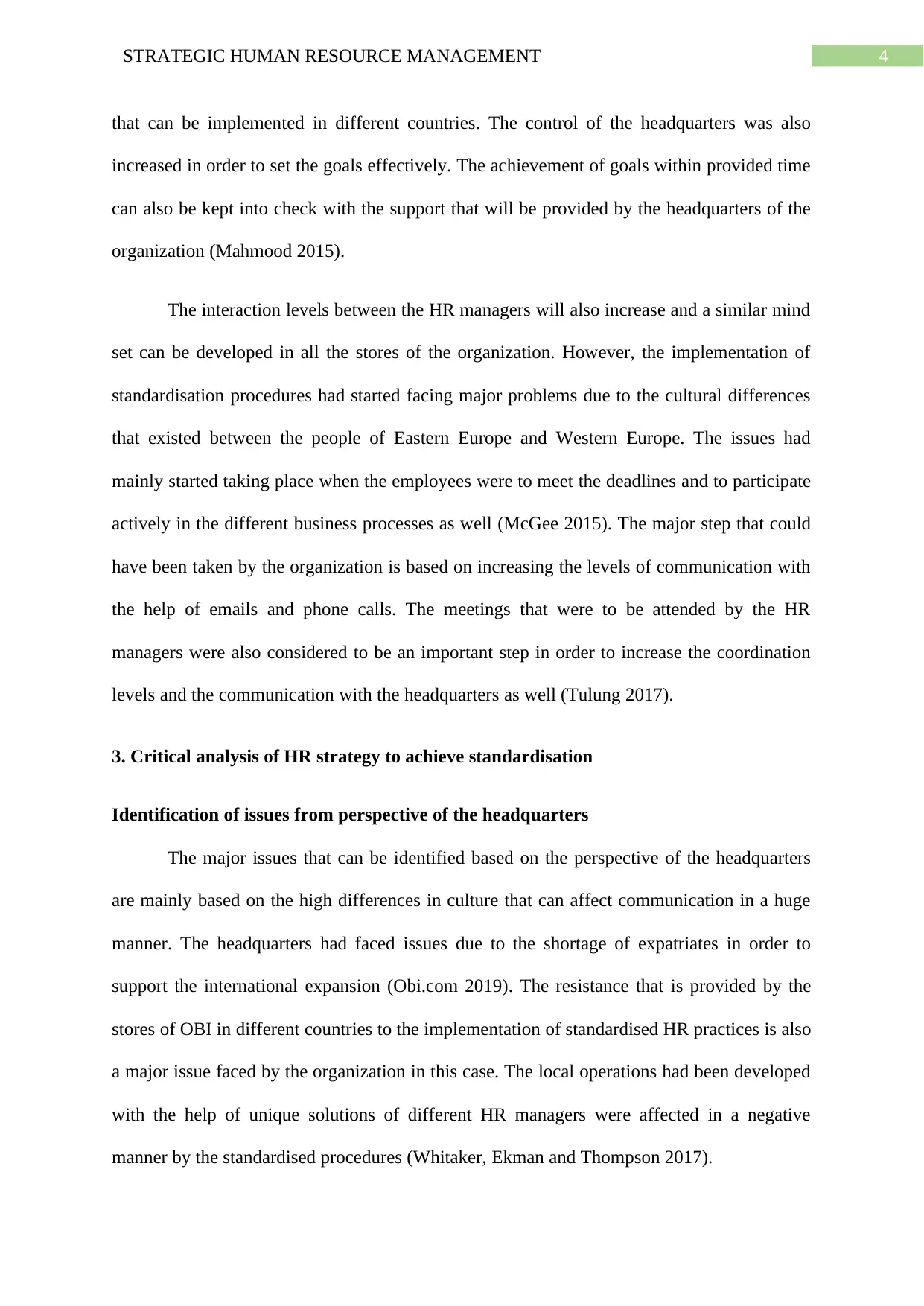
4STRATEGIC HUMAN RESOURCE MANAGEMENT
that can be implemented in different countries. The control of the headquarters was also
increased in order to set the goals effectively. The achievement of goals within provided time
can also be kept into check with the support that will be provided by the headquarters of the
organization (Mahmood 2015).
The interaction levels between the HR managers will also increase and a similar mind
set can be developed in all the stores of the organization. However, the implementation of
standardisation procedures had started facing major problems due to the cultural differences
that existed between the people of Eastern Europe and Western Europe. The issues had
mainly started taking place when the employees were to meet the deadlines and to participate
actively in the different business processes as well (McGee 2015). The major step that could
have been taken by the organization is based on increasing the levels of communication with
the help of emails and phone calls. The meetings that were to be attended by the HR
managers were also considered to be an important step in order to increase the coordination
levels and the communication with the headquarters as well (Tulung 2017).
3. Critical analysis of HR strategy to achieve standardisation
Identification of issues from perspective of the headquarters
The major issues that can be identified based on the perspective of the headquarters
are mainly based on the high differences in culture that can affect communication in a huge
manner. The headquarters had faced issues due to the shortage of expatriates in order to
support the international expansion (Obi.com 2019). The resistance that is provided by the
stores of OBI in different countries to the implementation of standardised HR practices is also
a major issue faced by the organization in this case. The local operations had been developed
with the help of unique solutions of different HR managers were affected in a negative
manner by the standardised procedures (Whitaker, Ekman and Thompson 2017).
that can be implemented in different countries. The control of the headquarters was also
increased in order to set the goals effectively. The achievement of goals within provided time
can also be kept into check with the support that will be provided by the headquarters of the
organization (Mahmood 2015).
The interaction levels between the HR managers will also increase and a similar mind
set can be developed in all the stores of the organization. However, the implementation of
standardisation procedures had started facing major problems due to the cultural differences
that existed between the people of Eastern Europe and Western Europe. The issues had
mainly started taking place when the employees were to meet the deadlines and to participate
actively in the different business processes as well (McGee 2015). The major step that could
have been taken by the organization is based on increasing the levels of communication with
the help of emails and phone calls. The meetings that were to be attended by the HR
managers were also considered to be an important step in order to increase the coordination
levels and the communication with the headquarters as well (Tulung 2017).
3. Critical analysis of HR strategy to achieve standardisation
Identification of issues from perspective of the headquarters
The major issues that can be identified based on the perspective of the headquarters
are mainly based on the high differences in culture that can affect communication in a huge
manner. The headquarters had faced issues due to the shortage of expatriates in order to
support the international expansion (Obi.com 2019). The resistance that is provided by the
stores of OBI in different countries to the implementation of standardised HR practices is also
a major issue faced by the organization in this case. The local operations had been developed
with the help of unique solutions of different HR managers were affected in a negative
manner by the standardised procedures (Whitaker, Ekman and Thompson 2017).
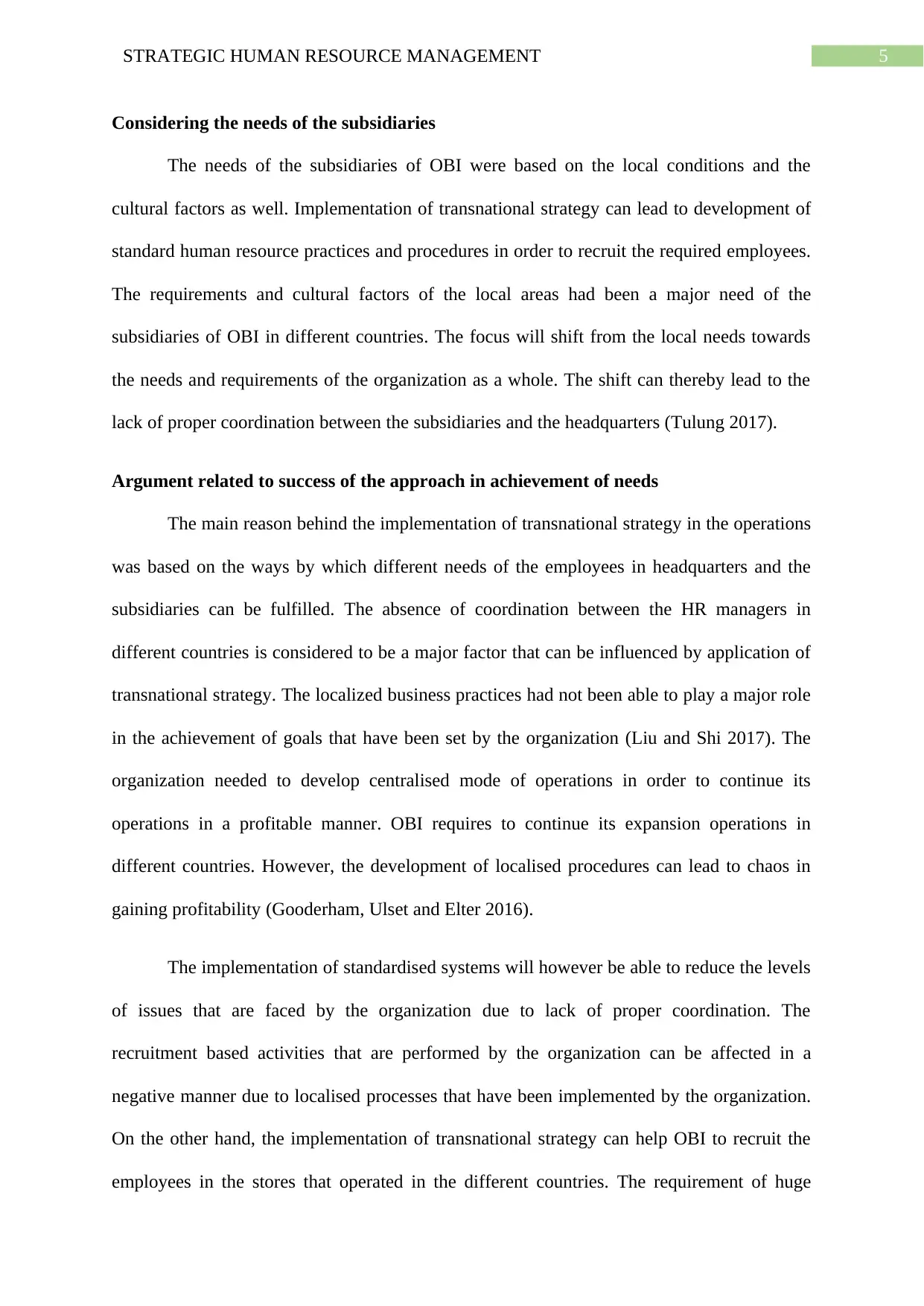
5STRATEGIC HUMAN RESOURCE MANAGEMENT
Considering the needs of the subsidiaries
The needs of the subsidiaries of OBI were based on the local conditions and the
cultural factors as well. Implementation of transnational strategy can lead to development of
standard human resource practices and procedures in order to recruit the required employees.
The requirements and cultural factors of the local areas had been a major need of the
subsidiaries of OBI in different countries. The focus will shift from the local needs towards
the needs and requirements of the organization as a whole. The shift can thereby lead to the
lack of proper coordination between the subsidiaries and the headquarters (Tulung 2017).
Argument related to success of the approach in achievement of needs
The main reason behind the implementation of transnational strategy in the operations
was based on the ways by which different needs of the employees in headquarters and the
subsidiaries can be fulfilled. The absence of coordination between the HR managers in
different countries is considered to be a major factor that can be influenced by application of
transnational strategy. The localized business practices had not been able to play a major role
in the achievement of goals that have been set by the organization (Liu and Shi 2017). The
organization needed to develop centralised mode of operations in order to continue its
operations in a profitable manner. OBI requires to continue its expansion operations in
different countries. However, the development of localised procedures can lead to chaos in
gaining profitability (Gooderham, Ulset and Elter 2016).
The implementation of standardised systems will however be able to reduce the levels
of issues that are faced by the organization due to lack of proper coordination. The
recruitment based activities that are performed by the organization can be affected in a
negative manner due to localised processes that have been implemented by the organization.
On the other hand, the implementation of transnational strategy can help OBI to recruit the
employees in the stores that operated in the different countries. The requirement of huge
Considering the needs of the subsidiaries
The needs of the subsidiaries of OBI were based on the local conditions and the
cultural factors as well. Implementation of transnational strategy can lead to development of
standard human resource practices and procedures in order to recruit the required employees.
The requirements and cultural factors of the local areas had been a major need of the
subsidiaries of OBI in different countries. The focus will shift from the local needs towards
the needs and requirements of the organization as a whole. The shift can thereby lead to the
lack of proper coordination between the subsidiaries and the headquarters (Tulung 2017).
Argument related to success of the approach in achievement of needs
The main reason behind the implementation of transnational strategy in the operations
was based on the ways by which different needs of the employees in headquarters and the
subsidiaries can be fulfilled. The absence of coordination between the HR managers in
different countries is considered to be a major factor that can be influenced by application of
transnational strategy. The localized business practices had not been able to play a major role
in the achievement of goals that have been set by the organization (Liu and Shi 2017). The
organization needed to develop centralised mode of operations in order to continue its
operations in a profitable manner. OBI requires to continue its expansion operations in
different countries. However, the development of localised procedures can lead to chaos in
gaining profitability (Gooderham, Ulset and Elter 2016).
The implementation of standardised systems will however be able to reduce the levels
of issues that are faced by the organization due to lack of proper coordination. The
recruitment based activities that are performed by the organization can be affected in a
negative manner due to localised processes that have been implemented by the organization.
On the other hand, the implementation of transnational strategy can help OBI to recruit the
employees in the stores that operated in the different countries. The requirement of huge
⊘ This is a preview!⊘
Do you want full access?
Subscribe today to unlock all pages.

Trusted by 1+ million students worldwide
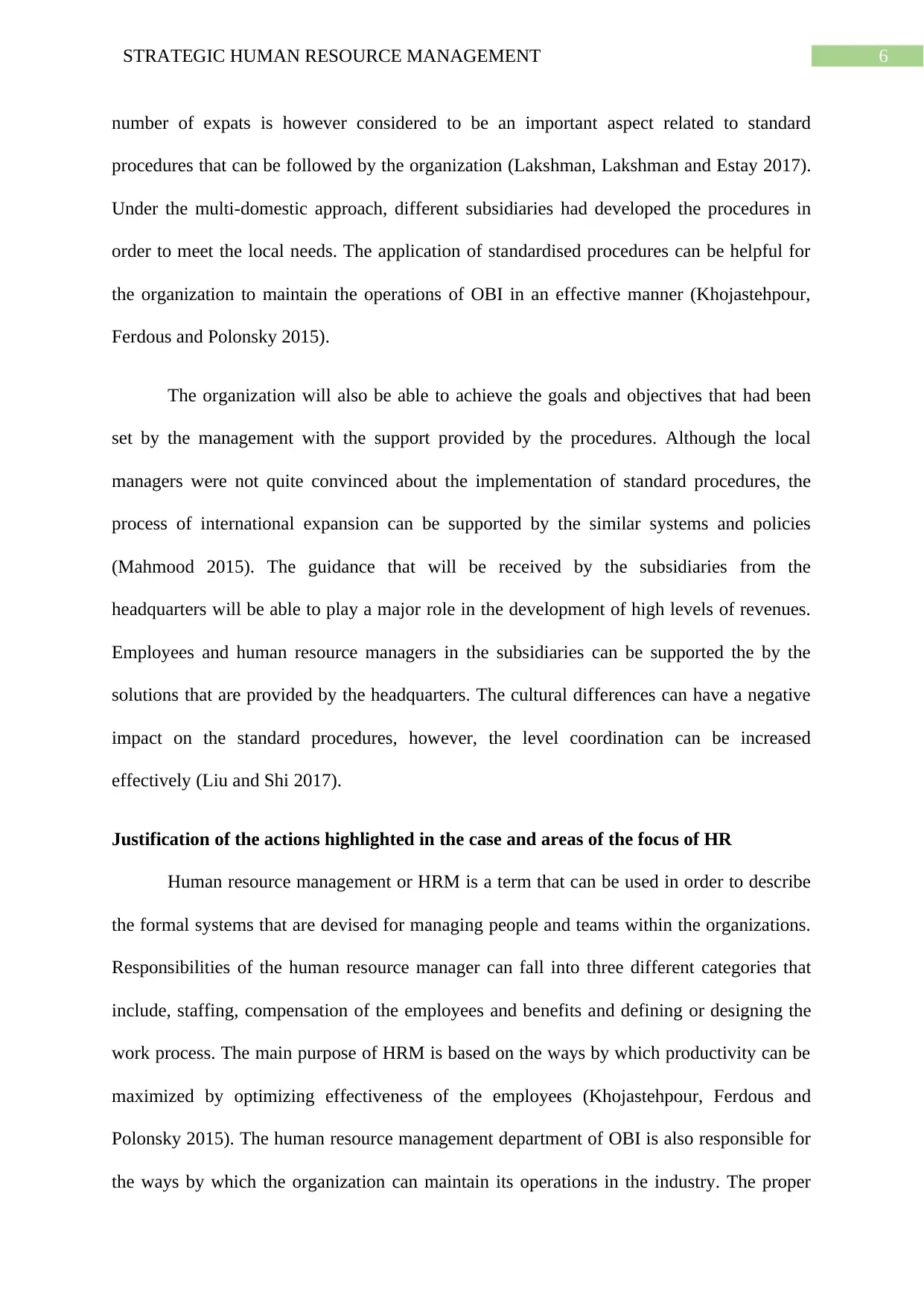
6STRATEGIC HUMAN RESOURCE MANAGEMENT
number of expats is however considered to be an important aspect related to standard
procedures that can be followed by the organization (Lakshman, Lakshman and Estay 2017).
Under the multi-domestic approach, different subsidiaries had developed the procedures in
order to meet the local needs. The application of standardised procedures can be helpful for
the organization to maintain the operations of OBI in an effective manner (Khojastehpour,
Ferdous and Polonsky 2015).
The organization will also be able to achieve the goals and objectives that had been
set by the management with the support provided by the procedures. Although the local
managers were not quite convinced about the implementation of standard procedures, the
process of international expansion can be supported by the similar systems and policies
(Mahmood 2015). The guidance that will be received by the subsidiaries from the
headquarters will be able to play a major role in the development of high levels of revenues.
Employees and human resource managers in the subsidiaries can be supported the by the
solutions that are provided by the headquarters. The cultural differences can have a negative
impact on the standard procedures, however, the level coordination can be increased
effectively (Liu and Shi 2017).
Justification of the actions highlighted in the case and areas of the focus of HR
Human resource management or HRM is a term that can be used in order to describe
the formal systems that are devised for managing people and teams within the organizations.
Responsibilities of the human resource manager can fall into three different categories that
include, staffing, compensation of the employees and benefits and defining or designing the
work process. The main purpose of HRM is based on the ways by which productivity can be
maximized by optimizing effectiveness of the employees (Khojastehpour, Ferdous and
Polonsky 2015). The human resource management department of OBI is also responsible for
the ways by which the organization can maintain its operations in the industry. The proper
number of expats is however considered to be an important aspect related to standard
procedures that can be followed by the organization (Lakshman, Lakshman and Estay 2017).
Under the multi-domestic approach, different subsidiaries had developed the procedures in
order to meet the local needs. The application of standardised procedures can be helpful for
the organization to maintain the operations of OBI in an effective manner (Khojastehpour,
Ferdous and Polonsky 2015).
The organization will also be able to achieve the goals and objectives that had been
set by the management with the support provided by the procedures. Although the local
managers were not quite convinced about the implementation of standard procedures, the
process of international expansion can be supported by the similar systems and policies
(Mahmood 2015). The guidance that will be received by the subsidiaries from the
headquarters will be able to play a major role in the development of high levels of revenues.
Employees and human resource managers in the subsidiaries can be supported the by the
solutions that are provided by the headquarters. The cultural differences can have a negative
impact on the standard procedures, however, the level coordination can be increased
effectively (Liu and Shi 2017).
Justification of the actions highlighted in the case and areas of the focus of HR
Human resource management or HRM is a term that can be used in order to describe
the formal systems that are devised for managing people and teams within the organizations.
Responsibilities of the human resource manager can fall into three different categories that
include, staffing, compensation of the employees and benefits and defining or designing the
work process. The main purpose of HRM is based on the ways by which productivity can be
maximized by optimizing effectiveness of the employees (Khojastehpour, Ferdous and
Polonsky 2015). The human resource management department of OBI is also responsible for
the ways by which the organization can maintain its operations in the industry. The proper
Paraphrase This Document
Need a fresh take? Get an instant paraphrase of this document with our AI Paraphraser
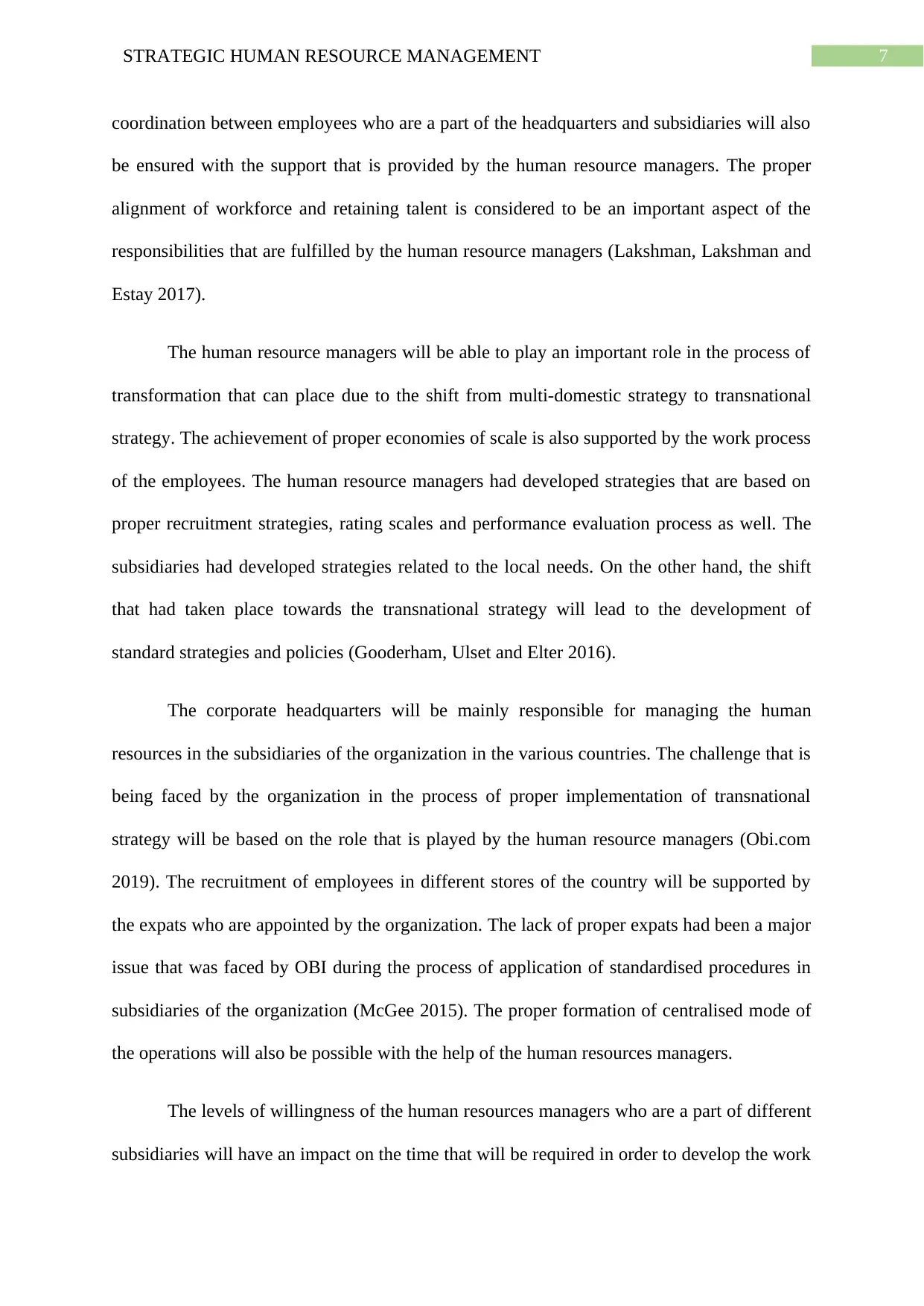
7STRATEGIC HUMAN RESOURCE MANAGEMENT
coordination between employees who are a part of the headquarters and subsidiaries will also
be ensured with the support that is provided by the human resource managers. The proper
alignment of workforce and retaining talent is considered to be an important aspect of the
responsibilities that are fulfilled by the human resource managers (Lakshman, Lakshman and
Estay 2017).
The human resource managers will be able to play an important role in the process of
transformation that can place due to the shift from multi-domestic strategy to transnational
strategy. The achievement of proper economies of scale is also supported by the work process
of the employees. The human resource managers had developed strategies that are based on
proper recruitment strategies, rating scales and performance evaluation process as well. The
subsidiaries had developed strategies related to the local needs. On the other hand, the shift
that had taken place towards the transnational strategy will lead to the development of
standard strategies and policies (Gooderham, Ulset and Elter 2016).
The corporate headquarters will be mainly responsible for managing the human
resources in the subsidiaries of the organization in the various countries. The challenge that is
being faced by the organization in the process of proper implementation of transnational
strategy will be based on the role that is played by the human resource managers (Obi.com
2019). The recruitment of employees in different stores of the country will be supported by
the expats who are appointed by the organization. The lack of proper expats had been a major
issue that was faced by OBI during the process of application of standardised procedures in
subsidiaries of the organization (McGee 2015). The proper formation of centralised mode of
the operations will also be possible with the help of the human resources managers.
The levels of willingness of the human resources managers who are a part of different
subsidiaries will have an impact on the time that will be required in order to develop the work
coordination between employees who are a part of the headquarters and subsidiaries will also
be ensured with the support that is provided by the human resource managers. The proper
alignment of workforce and retaining talent is considered to be an important aspect of the
responsibilities that are fulfilled by the human resource managers (Lakshman, Lakshman and
Estay 2017).
The human resource managers will be able to play an important role in the process of
transformation that can place due to the shift from multi-domestic strategy to transnational
strategy. The achievement of proper economies of scale is also supported by the work process
of the employees. The human resource managers had developed strategies that are based on
proper recruitment strategies, rating scales and performance evaluation process as well. The
subsidiaries had developed strategies related to the local needs. On the other hand, the shift
that had taken place towards the transnational strategy will lead to the development of
standard strategies and policies (Gooderham, Ulset and Elter 2016).
The corporate headquarters will be mainly responsible for managing the human
resources in the subsidiaries of the organization in the various countries. The challenge that is
being faced by the organization in the process of proper implementation of transnational
strategy will be based on the role that is played by the human resource managers (Obi.com
2019). The recruitment of employees in different stores of the country will be supported by
the expats who are appointed by the organization. The lack of proper expats had been a major
issue that was faced by OBI during the process of application of standardised procedures in
subsidiaries of the organization (McGee 2015). The proper formation of centralised mode of
the operations will also be possible with the help of the human resources managers.
The levels of willingness of the human resources managers who are a part of different
subsidiaries will have an impact on the time that will be required in order to develop the work
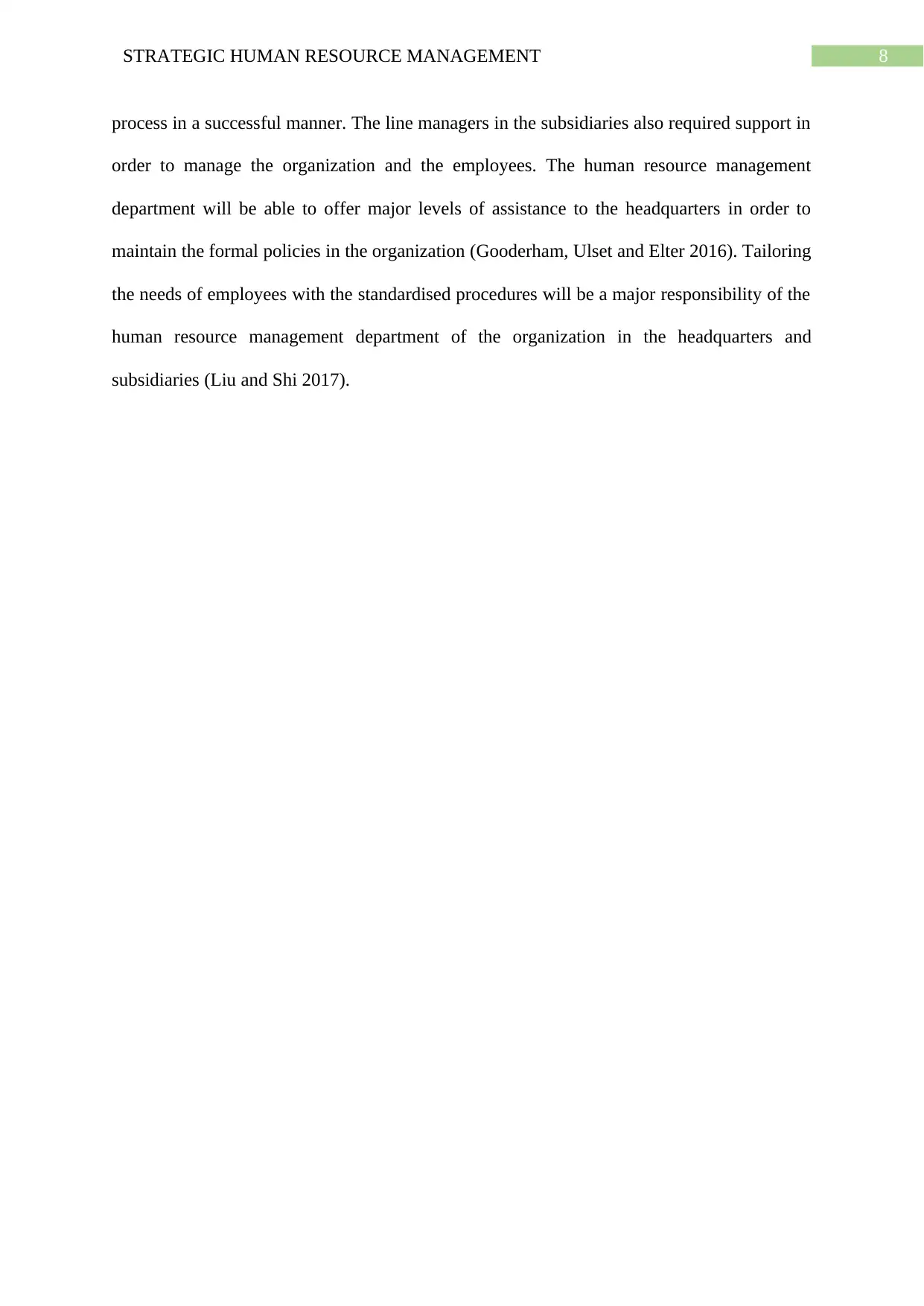
8STRATEGIC HUMAN RESOURCE MANAGEMENT
process in a successful manner. The line managers in the subsidiaries also required support in
order to manage the organization and the employees. The human resource management
department will be able to offer major levels of assistance to the headquarters in order to
maintain the formal policies in the organization (Gooderham, Ulset and Elter 2016). Tailoring
the needs of employees with the standardised procedures will be a major responsibility of the
human resource management department of the organization in the headquarters and
subsidiaries (Liu and Shi 2017).
process in a successful manner. The line managers in the subsidiaries also required support in
order to manage the organization and the employees. The human resource management
department will be able to offer major levels of assistance to the headquarters in order to
maintain the formal policies in the organization (Gooderham, Ulset and Elter 2016). Tailoring
the needs of employees with the standardised procedures will be a major responsibility of the
human resource management department of the organization in the headquarters and
subsidiaries (Liu and Shi 2017).
⊘ This is a preview!⊘
Do you want full access?
Subscribe today to unlock all pages.

Trusted by 1+ million students worldwide
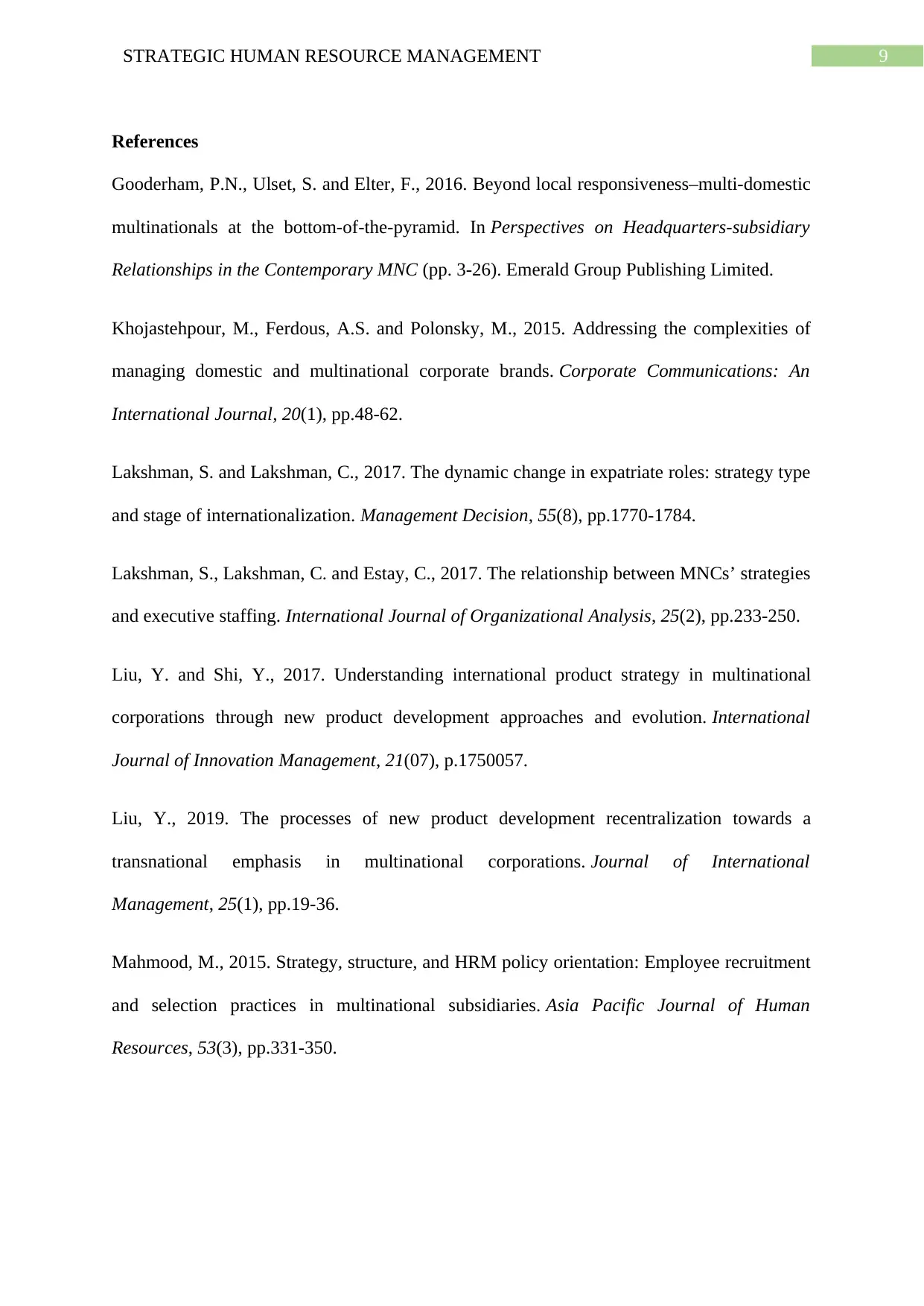
9STRATEGIC HUMAN RESOURCE MANAGEMENT
References
Gooderham, P.N., Ulset, S. and Elter, F., 2016. Beyond local responsiveness–multi-domestic
multinationals at the bottom-of-the-pyramid. In Perspectives on Headquarters-subsidiary
Relationships in the Contemporary MNC (pp. 3-26). Emerald Group Publishing Limited.
Khojastehpour, M., Ferdous, A.S. and Polonsky, M., 2015. Addressing the complexities of
managing domestic and multinational corporate brands. Corporate Communications: An
International Journal, 20(1), pp.48-62.
Lakshman, S. and Lakshman, C., 2017. The dynamic change in expatriate roles: strategy type
and stage of internationalization. Management Decision, 55(8), pp.1770-1784.
Lakshman, S., Lakshman, C. and Estay, C., 2017. The relationship between MNCs’ strategies
and executive staffing. International Journal of Organizational Analysis, 25(2), pp.233-250.
Liu, Y. and Shi, Y., 2017. Understanding international product strategy in multinational
corporations through new product development approaches and evolution. International
Journal of Innovation Management, 21(07), p.1750057.
Liu, Y., 2019. The processes of new product development recentralization towards a
transnational emphasis in multinational corporations. Journal of International
Management, 25(1), pp.19-36.
Mahmood, M., 2015. Strategy, structure, and HRM policy orientation: Employee recruitment
and selection practices in multinational subsidiaries. Asia Pacific Journal of Human
Resources, 53(3), pp.331-350.
References
Gooderham, P.N., Ulset, S. and Elter, F., 2016. Beyond local responsiveness–multi-domestic
multinationals at the bottom-of-the-pyramid. In Perspectives on Headquarters-subsidiary
Relationships in the Contemporary MNC (pp. 3-26). Emerald Group Publishing Limited.
Khojastehpour, M., Ferdous, A.S. and Polonsky, M., 2015. Addressing the complexities of
managing domestic and multinational corporate brands. Corporate Communications: An
International Journal, 20(1), pp.48-62.
Lakshman, S. and Lakshman, C., 2017. The dynamic change in expatriate roles: strategy type
and stage of internationalization. Management Decision, 55(8), pp.1770-1784.
Lakshman, S., Lakshman, C. and Estay, C., 2017. The relationship between MNCs’ strategies
and executive staffing. International Journal of Organizational Analysis, 25(2), pp.233-250.
Liu, Y. and Shi, Y., 2017. Understanding international product strategy in multinational
corporations through new product development approaches and evolution. International
Journal of Innovation Management, 21(07), p.1750057.
Liu, Y., 2019. The processes of new product development recentralization towards a
transnational emphasis in multinational corporations. Journal of International
Management, 25(1), pp.19-36.
Mahmood, M., 2015. Strategy, structure, and HRM policy orientation: Employee recruitment
and selection practices in multinational subsidiaries. Asia Pacific Journal of Human
Resources, 53(3), pp.331-350.
Paraphrase This Document
Need a fresh take? Get an instant paraphrase of this document with our AI Paraphraser
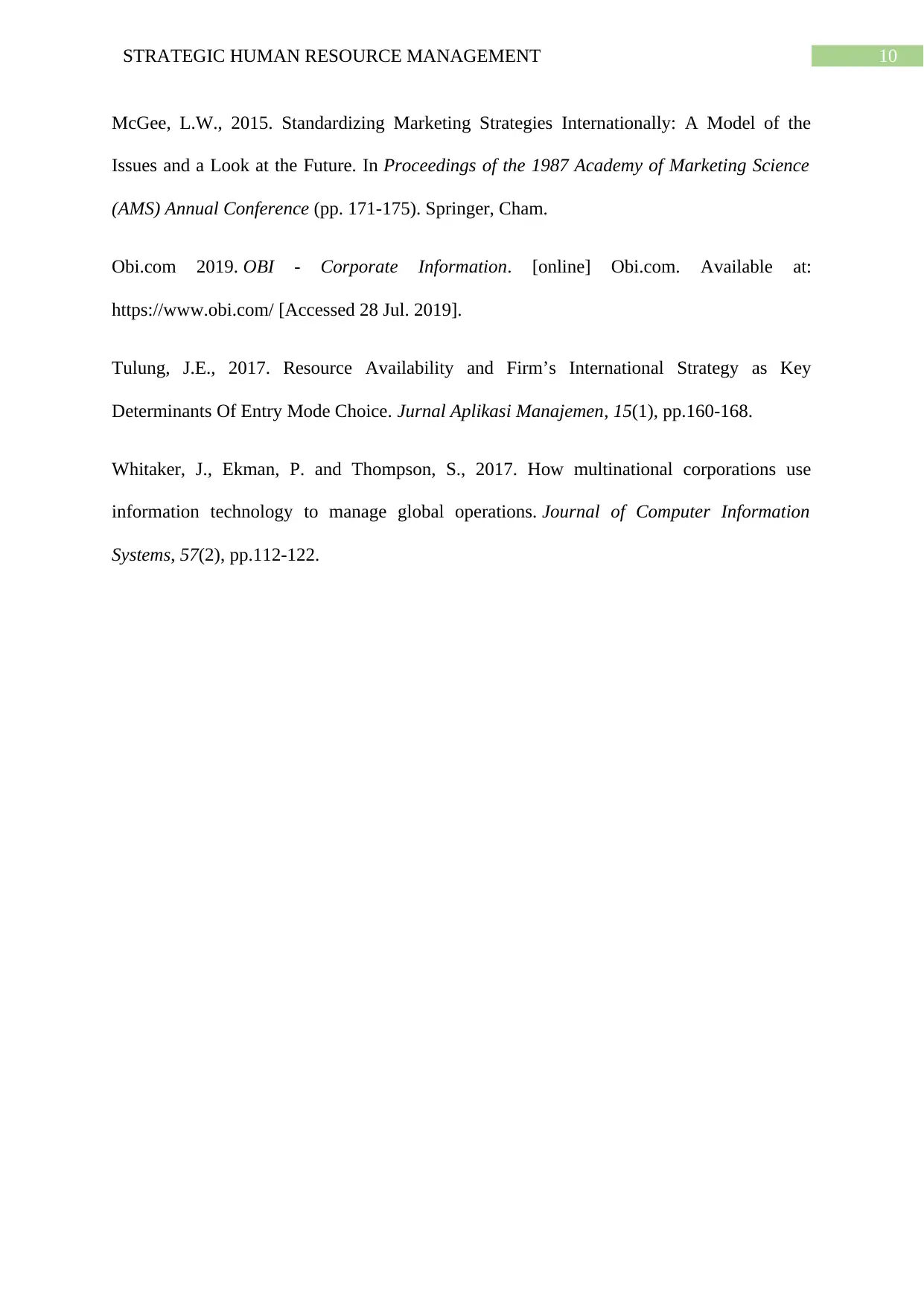
10STRATEGIC HUMAN RESOURCE MANAGEMENT
McGee, L.W., 2015. Standardizing Marketing Strategies Internationally: A Model of the
Issues and a Look at the Future. In Proceedings of the 1987 Academy of Marketing Science
(AMS) Annual Conference (pp. 171-175). Springer, Cham.
Obi.com 2019. OBI - Corporate Information. [online] Obi.com. Available at:
https://www.obi.com/ [Accessed 28 Jul. 2019].
Tulung, J.E., 2017. Resource Availability and Firm’s International Strategy as Key
Determinants Of Entry Mode Choice. Jurnal Aplikasi Manajemen, 15(1), pp.160-168.
Whitaker, J., Ekman, P. and Thompson, S., 2017. How multinational corporations use
information technology to manage global operations. Journal of Computer Information
Systems, 57(2), pp.112-122.
McGee, L.W., 2015. Standardizing Marketing Strategies Internationally: A Model of the
Issues and a Look at the Future. In Proceedings of the 1987 Academy of Marketing Science
(AMS) Annual Conference (pp. 171-175). Springer, Cham.
Obi.com 2019. OBI - Corporate Information. [online] Obi.com. Available at:
https://www.obi.com/ [Accessed 28 Jul. 2019].
Tulung, J.E., 2017. Resource Availability and Firm’s International Strategy as Key
Determinants Of Entry Mode Choice. Jurnal Aplikasi Manajemen, 15(1), pp.160-168.
Whitaker, J., Ekman, P. and Thompson, S., 2017. How multinational corporations use
information technology to manage global operations. Journal of Computer Information
Systems, 57(2), pp.112-122.
1 out of 11
Related Documents
Your All-in-One AI-Powered Toolkit for Academic Success.
+13062052269
info@desklib.com
Available 24*7 on WhatsApp / Email
![[object Object]](/_next/static/media/star-bottom.7253800d.svg)
Unlock your academic potential
Copyright © 2020–2025 A2Z Services. All Rights Reserved. Developed and managed by ZUCOL.





